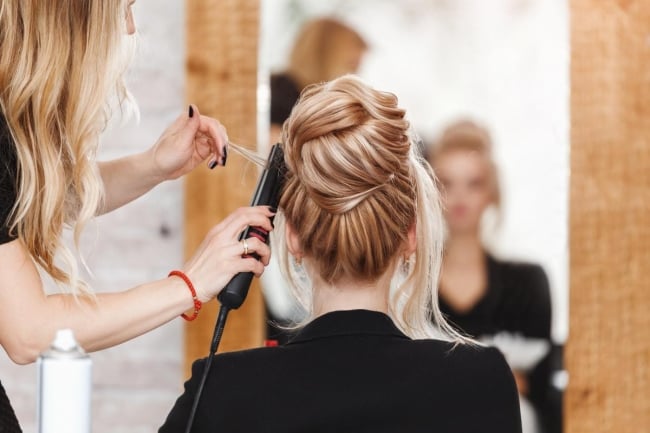You have /5 articles left.
Sign up for a free account or log in.

Istockphoto.com/frantic00
Neal Heller, who owns two beauty school chains, apologized for being on the phone when a reporter called Tuesday.
“I was putting in an order for hand sanitizer,” he said from his home in Hollywood, Fla., which, as is the case for many people, has been functioning as Heller's office. A small bottle of hand sanitizer sat on his desk, as did the mask he puts on when he goes out.
While much has been made of the struggles of colleges and universities during the pandemic, Heller’s schools -- the Hollywood Institute of Beauty Careers and Cortiva Institutes, which teaches skin care and massage -- also had to go online.
But there’s only so much students can learn about doing hair, painting nails or putting on makeup from watching a video. Soon, Heller hopes, his students and instructors will be back to working hands-on.
Which is why, in addition to ordering 96 gallons of hand sanitizer, Heller said he’s also ordering 26,000 face masks.
However, according to an Inside Higher Ed tally of who will receive the billions in funds Congress set aside for higher education, beauty schools are getting tens of millions of dollars in help.
When Congress passed its coronavirus relief package last month, known as the CARES Act, it included about $12 billion to help colleges and universities that are reeling from the financial hit of the pandemic to the point where some are on the brink of shutting down. Half the money must go to students through emergency grants.
But besides the money going to institutions such the University of California and for-profit institutions like Grand Canyon University, $26.5 million in higher education dollars is going to the Paul Mitchell beauty schools. Higher education dollars are also headed in smaller amounts to about 700 other beauty schools, like Arnold’s Beauty School in Milan, Tenn., which will get $68,240, or the B-Unique Beauty and Barber Academy in Greenville, S.C., which will get $71,620.
Heller's Hollywood Institute of Beauty Careers will get $1.5 million, and the Cortiva Institutes will get almost $3 million.
Mr. John's School of Cosmetology & Nails, located in Jacksonville, Fla., will get $52,727, while Mr. John's School of Cosmetology, Esthetics & Nails in Decatur, Ill., will get $115,442, and Mr. Leon's School of Hair Design in Moscow and Lewiston, Idaho, will get $89,201, according to Education Department data.
In all, beauty schools, including hair, nail, esthetician and cosmetology and barber schools, will get $164 million in higher education funds from the stimulus package. The students who receive grant aid from the stimulus are those who are eligible to receive federal financial aid, now and before the pandemic.
Two large chains, Paul Mitchell and Empire Beauty Schools, are receiving enough to be among the top 10 winners among the for-profit sector. The $26 million Paul Mitchell is receiving and the $18.3 million going to Empire are about the same as what was allocated to the University of Michigan, which is receiving $25.2 million, or the Universities of Oklahoma and Kentucky, which each are getting about $18 million.
‘Not a Time to Fight About Sectors’
That tens of millions of dollars are going to train hairstylists, barbers and manicurists instead of scientists and doctors is not drawing the ire of associations that represent colleges and universities in Washington, D.C., even as they lament that the $14 billion share of the CARES Act is not nearly enough to deal with the financial fallout of the pandemic and are asking for another $46 billion as a growing number of colleges announce employee furloughs and layoffs.
The $160 million going to beauty schools is a relatively small amount, making up about 9 percent of the $1.1 billion in higher education stimulus funds allocated to for-profits, according to the analysis by Inside Higher Ed. And even the money going to Paul Mitchell Schools, which did not return emails for comment, pales compared to the $63 million the stimulus package's biggest higher education winner, Arizona State University, is getting.
“When there’s a vast need there for emergency aid for students and institutions, it’s not a time to fight about sectors or shares,” said Terry Hartle, the American Council on Education’s senior vice president for government and public affairs.
Meanwhile, a Republican aide on the Senate education committee argued in an email that “All Title IV-eligible institutions are eligible for aid. It’s elitist to suggest that working-class, technical and career-oriented institutions shouldn’t receive assistance. Their students are among the hardest hit by the economic crisis caused by COVID-19, and when schools are allowed to reopen, these institutions are going to be part of the recovery.”
But what the funding for beauty schools does point to, said David Baime, the American Association of Community Colleges’ senior vice president for government relations and policy analysis, is how higher education funding is stretched across all sorts of kinds of institutions. When Congress decided to fund for-profits in the stimulus package, the fact “that it would be funding a wide range of every imaginable educational program just comes with the territory,” he said.
In distributing the money, Congress set a formula based on colleges' enrollment numbers of low-income students who are eligible to receive Pell Grants. Because students can use those federal grants for a variety of kinds of postsecondary programs, the stimulus funds are going to a wide range of institutions, including those training ballet dancers, acupuncturists, massage therapists and, in the case of Charlie's Guard-Detective Bureau and Academy in Puerto Rico, private detectives.
Higher education groups “are fatalistic about it,” Baime said, referring to the idea that higher education money is spread widely.
Indeed, the $160 million to train people to make other people look better doesn’t include the $37,149 in higher education dollars going to the Merryfield School of Pet Grooming, in Fort Lauderdale, Fla. Or the $5,656 going to the Pets Playground Grooming School in Pompano Beach, Fla.
And colleges likely will need Congress to provide even more higher education funds than the $46 billion more the industry is seeking, because that amount does not include the cut for beauty and other schools.
However, beauty and other schools may be caught up in controversy over funding some types of for-profits after a number of high-profile scandals in the sector, such as the high-profile collapse of Corinthian Colleges and examples of for-profits misleading prospective students about their prospects of being able to find work after completing programs.
Earlier this week, congressional Democrats, including Senators Dick Durbin of Illinois and Elizabeth Warren of Massachusetts, wrote legislative leaders in opposition to allocating additional education stimulus dollars to for-profits.
Though the senators have not singled out beauty schools, some institutions in that sector have been criticized for charging high tuition when they often lead to low-paying jobs. Baime said all for-profits that receive federal education dollars should be held accountable if students don't make enough money to repay student loans, although opponents of the idea say its unfair to single out for-profits for the scrutiny.
Cosmetology Online
Heller, however, said the thing about cutting someone’s hair or doing their nails or putting makeup on them is that you need to be within six feet of their head, fingers or toes. And he said cosmetology schools are struggling as much as colleges.
“It’s had a tremendous impact on beauty schools,” he said. “We don't typically teach online. None of us had done that before.”
At his schools, students typically do some hands-on work with mannequins or plastic hands at the beginning of courses. But instructors also teach the theory behind styling hair or doing makeup. Right now, that’s what students are learning online, he said.
But to get licensed, students eventually will work on real clients at hair studios, with an instructor close by. Heller hopes the studios will be open in June. But for now, they’re closed.
His schools also are considering other changes, like having manicurists work from behind plastic. "If you’ve been to Whole Foods lately, they have Plexiglas at the checkout counters. We’ve been looking into that," he said. But that would cost money.
Many of his students are from minority groups and are low income. Some also have children who are no longer going to school during the pandemic. With many not having computers at home or having to take care of their kids, about half have dropped out, he said.
“It’s unfair that some out there in Congress are trying to make a distinction over which schools and colleges be funded,” he said.
And, he argued, they’re not like big universities like Harvard, which was criticized by U.S. Education Secretary Betsy DeVos on Tuesday for taking stimulus dollars instead of drawing on its $40 billion endowment. (The university has said it will not accept its stimulus money, as have several other wealthy universities.)
"We’re not huge schools with millions of dollars in endowments and access to money from alumni," he said. "We’re small business operators, and we’re being severely impacted."




